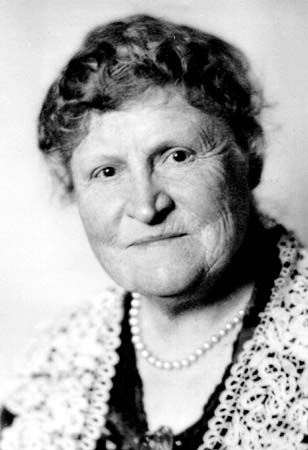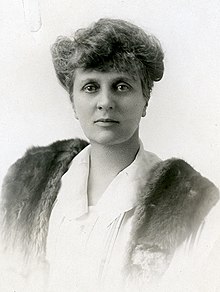The Famous Five, also known as The Valiant Five, and initially as The Alberta Five, were five prominent Canadian suffragists who advocated for women and children: Henrietta Muir Edwards, Nellie McClung, Louise McKinney, Emily Murphy, and Irene Parlby. On August 27, 1927, they petitioned the federal government to refer the issue of the eligibility of women to be senator to the Supreme Court of Canada. This petition was the foundation of the Persons Case, a leading constitutional decision. Although most Canadian women had the vote in federal elections and all provinces but Quebec by 1927, the case was part of a larger drive for political equality. This was the first step towards equality for women in Canada and was the start to the first wave of feminism.

Nellie Letitia McClung was a Canadian author, politician, and social activist, who is regarded as one of Canada's most prominent suffragists. She began her career in writing with the 1908 book Sowing Seeds in Danny, and would eventually publish sixteen books, including two autobiographies. She played a leading role in the women's suffrage movement in Canada, helping to grant women the vote in Alberta and Manitoba in 1916. McClung was elected to the Legislative Assembly of Alberta in 1921, where she served until 1926.

Emily Murphy was a Canadian women's rights activist and author. In 1916, she became the first female magistrate in Canada and the fifth in the British Empire after Elizabeth Webb Nicholls, Jane Price, E. Cullen and Cecilia Dixon of Australia. She is best known for her contributions to Canadian feminism, specifically to the question of whether women were "persons" under Canadian law.

Louise McKinney was a Canadian politician, temperance advocate, and women's rights activist. She was the first woman elected into the Legislative Assembly of Alberta and the first woman to serve in a legislature in the British Empire. She served in the Alberta legislature from 1917 to 1921 as a member of the Non-Partisan League. Later she was one of the Famous Five who campaigned successfully for the right of Canadian women to be appointed to the Senate. A former schoolteacher and temperance organizer, she came to Alberta in 1903 as a homesteader.

Elaine Jean McCoy was a Canadian politician from Alberta. She was a member of the Senate of Canada.

Drayton Valley-Calmar was a provincial electoral district in Alberta, Canada, mandated to return a single member to the Legislative Assembly of Alberta using the first-past-the-post method of voting from 1993 to 2012.

Edmonton Meadowlark was a provincial electoral district in Alberta, Canada, mandated to return a single member to the Legislative Assembly of Alberta using the first past the post method of voting from 1971 to 2019.

Henrietta Muir Edwards was a Canadian women's rights activist, author and reformer. She was the eldest of "The Famous Five", along with Emily Murphy, Nellie McClung, Louise McKinney and Irene Parlby, who fought to have women recognized as "persons" under the law, and for the woman's right to vote in elections.

Lacombe is a city in central Alberta, Canada. It is located approximately 25 kilometres (16 mi) north of Red Deer, the nearest major city, and 125 kilometres (78 mi) south of Edmonton, the nearest metropolitan area. The city is set in the rolling parkland of central Alberta, between the Rocky Mountains foothills to the west and the flatter Alberta prairie to the east.

Violet Louise Archer was a Canadian composer, teacher, pianist, organist, and percussionist. Born Violet Balestreri in Montreal, Quebec, in 1913, her family changed their name to Archer in 1940. She died in Ottawa on 21 February 2000.

Edwards v Canada (AG), also known as the Persons Case (French: l'Affaire « personne »), is a Canadian constitutional case that decided in 1929 that women were eligible to sit in the Senate of Canada. The legal case was put forward by the Government of Canada on the lobbying of a group of women known as The Famous Five—Henrietta Edwards, Nellie McClung, Louise McKinney, Emily Murphy and Irene Parlby. The case began as a reference case by the federal Cabinet directly to the Supreme Court of Canada, which ruled that women were not "qualified persons" and thus ineligible to sit in the Senate. The five women then appealed to the Judicial Committee of the Imperial Privy Council in London, at that time the court of last resort for Canada within the British Empire and Commonwealth. The Judicial Committee overturned the Supreme Court's decision. (The case name lists Edwards as the lead appellant, as her name came first alphabetically.)
Representation by women has been a significant issue in Canadian politics since 1900.

Alix is a village in central Alberta, Canada that is northeast of Red Deer. Its village mascot is the Alix-Gator, who is featured prominently on many signs and businesses.
The Alberta Eugenics Board was an agency created by the Alberta government in 1928 that attempted to impose sterilization on a disabled subset of its population, in accordance with the principles of eugenics. It remained active until 1972, when it was dissolved.

Nurses in Canada practise in a wide variety of settings, with various levels of training and experience. They provide evidence-based care and educate their patients about health and disease.

Edith Blanche Rogers was a Canadian politician who served as a member of the Legislative Assembly of Alberta from 1935 until 1940. Born in Nova Scotia, she came west to Alberta to accept a job as a teacher. She later moved to Calgary where she encountered evangelist William Aberhart and became a convert to his social credit economic theories. After advocating these theories across the province, she was elected in the 1935 provincial election as a candidate of Aberhart's newly formed Social Credit League.
Persons Day is an annual celebration in Canada, held on October 18. The day commemorates the case of Edwards v. Canada , more commonly known as The Persons Case – a famous Canadian constitutional case decided on October 18, 1929, by the Judicial Committee of the Imperial Privy Council, which at that time was the court of last resort for Canada. The Persons Case held that women were eligible to sit in the Senate of Canada.

Lizzie Cyr was a Canadian woman known for her role in a seminal Canadian court case. Cyr was charged with "vagrancy" by Calgary Police, in 1917. Vagrancy was, at that time, a euphemism for prostitution. The john who reported her claimed she had infected him with gonorrhea.
Claresholm was a provincial electoral district in Alberta mandated to return a single member to the Legislative Assembly of Alberta using the first past the post method of voting from 1909 to 1929.

The United Farm Women of Alberta, later the Farm Women's Union of Alberta and Women of Unifarm, was a Canadian organization between 1915 and 2000. Originally founded as an auxiliary group of the United Farmers of Alberta in 1915, its members voted to make it a separate organization the following year. The group was a more rural alternative to some women than other groups of the time, such as the Woman's Christian Temperance Union and the National Council of Women. The UFWA mainly focused on improving healthcare and education for rural communities.


















